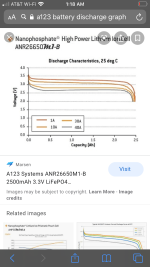Hummina Shadeeba
1 MW
battery resistance testers such as this:
https://www.amazon.com/gp/aw/d/B07W3TCRYL/ref=psdcmw_14244451_t1_B0716ZL1SM#aw-udpv3-customer-reviews_feature_div
aren’t a good revealer of capacity or cycles left and I’m looking for an easy and cheap test rig I could assemble for multiple cells at once.
They’re lithium iron cells.
Can I charge them all to the same 3.6 full voltage, probably while in parallel to make it quick and easy, then connect them separately to an led (and maybe a transistor for greater voltage precision and maybe a resistor) and the bulb would turn off when the cell discharged to an exact voltage?
I read a transistor would have much better precision relating to voltage:
https://www.nutsvolts.com/magazine/article/build_a_01_accurate_voltage_reference
https://www.amazon.com/gp/aw/d/B07W3TCRYL/ref=psdcmw_14244451_t1_B0716ZL1SM#aw-udpv3-customer-reviews_feature_div
aren’t a good revealer of capacity or cycles left and I’m looking for an easy and cheap test rig I could assemble for multiple cells at once.
They’re lithium iron cells.
Can I charge them all to the same 3.6 full voltage, probably while in parallel to make it quick and easy, then connect them separately to an led (and maybe a transistor for greater voltage precision and maybe a resistor) and the bulb would turn off when the cell discharged to an exact voltage?
I read a transistor would have much better precision relating to voltage:
https://www.nutsvolts.com/magazine/article/build_a_01_accurate_voltage_reference


